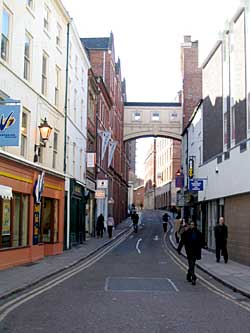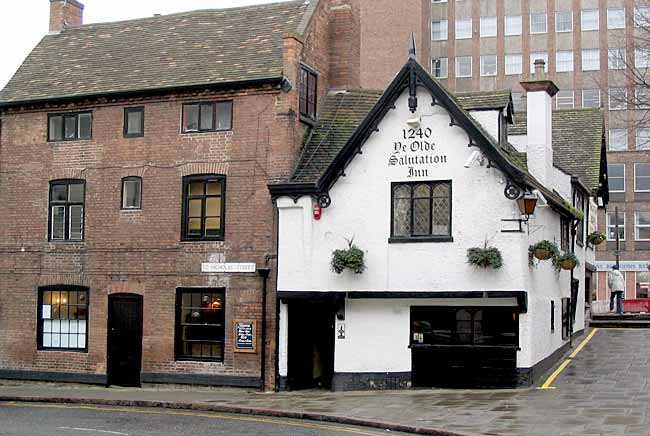< Previous | Contents | Next >
Hounds Gate

Hounds Gate from St Peter's Square (A Nicholson, 2004).
Houndsgate is of extreme antiquity, being a section of the earliest primeval track in this neighbourhood, which, as we have already seen, was pushed northwards by the castle enclosure. When it first received its name I cannot say, but the suffix "gate" points to Danish times, possibly in the 9th century.
Anyway it was called "Hungate" in 1326 so that its name has altered little during the last six centuries, and as the castle gateway is set directly for it, it is obvious that it must have been an important thoroughfare—far more important than Friar Lane and Park Street—all through the Middle Ages. Its importance is reflected in the fact that it was a paved road in ancient times, for when excavations were being made at its western end in 1797 an ancient paved carriage-way was found fourteen feet below the present street level. Its narrowness gives us some idea of the difficulties and inconveniences that our forefathers had to contend with in dealing with traffic in medieval streets.
The most interesting building in the street is undoubtedly the "Salutation" Inn at the corner of St. Nicholas Street and Houndsgate. Although masked by rough-cast it is a half-timbered structure dating from the 15th century, possibly about the time of the Battle of Agincourt, and its delightful gables and drop-shutters have a true medieval flavour. The "Salutation" to which the sign refers is the ave Maria plena gratia whereby the Archangel Gabriel saluted the Blessed Virgin Mary, and was a sign not infrequently used on guest houses associated with religious establishments. It may be purely fortuitous, but this inn is situated half-way between the establishment of the Carmelites in Friar Yard and the Franciscans in Grey Friar Gate. There appears to be no documentary connection between "The Salutation" and either of these friaries, but it is just possible that it represents the guest house of one or the other. It was a place of considerable importance in time past and in it have been held many banquets of a public and quasi-public nature, for example on November 4th, 1788, a banquet was held here to commemorate the Revolution of 1688, which was attended by a large and influential company. The toast-list has been preserved by Sutton in his Date Book and certainly is sufficiently loyal. "The King, and may he ever follow the example of his royal ancestors, and glory in the name of Briton" is a specimen.

The Salutation Inn on Hounds Gate (A Nicholson, 2004).
The tragedy of the house occurred in 1820. A quantity of arsenic was procured for the destruction of rats and this somehow got mixed with the domestic supply of oatmeal. The whole household were poisoned but all recovered with the exception of John Green, the landlord.
Of course, Tobias could not keep away from such quarters as "The Salutation" and accordingly in 1729 we find him stopping here. Coney was in jail at Newark and Martha was in great financial straits. She had sold goods to Tobias on many occasions and evidently must have applied to him for assistance for there is a note in his journal that he gave her £2 because of her wretched circumstances.
There are many curious little yards leading off Houndsgate, and many of them are really picturesque : particularly so is Risdale's Yard which takes its name from a certain John Risdale who was a baker and lived here in 1799. The curious old-world houses in this yard are really well worth study apart from their picturesqueness.
Of the tragic death of the daughter of Shaw the landlord of the Elephant and Castle we have already seen something when considering Grey Friar Gate, but the name of the Elephant and Castle is not without interest for it is a corruption of A L'enfant de Castile, the beloved Eleanor, wife of Edward I. who died at Harby in 1290 and whose heart is interred in Lincoln Cathedral and the pauses in whose stately funeral procession to Westminster are marked by the Eleanor Crosses which are so well-known to antiquaries. By degrees the origin of this name became lost and it was colloquialised into "The Elephant and Castle" and eventually that strange combination was adopted as the badge of the Cutlers Company, of London.
But the tragedy of Shaw's daughter is not the only one associated with Houndsgate, for in 1788 a most ghastly discovery was made in a wool warehouse occupied by one Jowitt in Houndsgate when the practically mummified body of a certain Mr. Rogers was discovered amongst the wool sacks in his warehouse. It was surmised that the unfortunate gentleman had laid down to rest upon some of these sacks and whilst asleep had slipped into the interstices between the packages and being unable to extricate himself had perished miserably by suffocation. There is a haunted house also in Houndsgate at present occupied by Messrs. Marsh and Creassey, the ghosts in which seem to have a penchant for playing billiards, for while the house was occupied by the late Mr. Alfred Page the click of billiard balls was continually heard in certain rooms. Beyond this harmless diversion and the somewhat futile proceeding of opening and closing doors the ghosts seem to have done nothing and I think probably that the real explanation lies in the fact that there are innumerable underground cellars and passages in this neighbourhood which would convey sounds in a strange manner and give rise to mysterious results.
The streamlet of the Rowell whose lower courses we noticed in Castle Gate must have been something of a nuisance to our forefathers for in 1587 we find that it was necessary to place a bridge across it in Hounds-gate and to provide rails for the safety of passengers, and this Rowell with its overflow may have had something to do with the insalubrious condition into which the lower end of Houndsgate got and which led to the White Rents which as we have seen were situated near the bottom end of Houndsgate becoming almost derelict and used as a resort by evil characters.
It is interesting to remember that the first town steward, John Collishaw, who was appointed in 1787 lived in Houndsgate and he only died so recently as 1809. The spectacular Bridge of Sighs, which connects the two portions of a great soft-goods warehouse and which spans Houndsgate in really rather a charming manner was erected in 1923.
